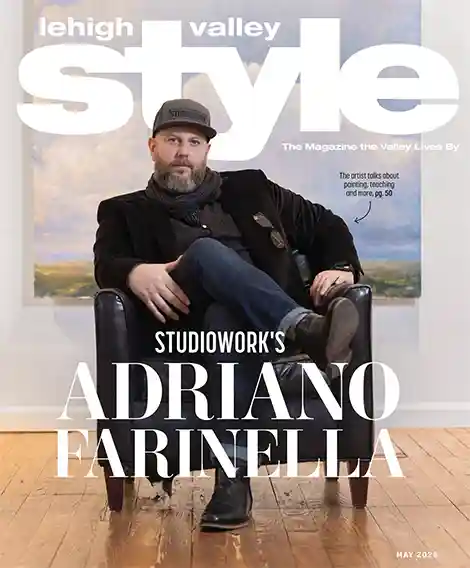Chloe Costigan, DPT, co-owner of Bethlehem-based Mobility-Doc, always wanted to have a career in which she helped people. When she was in high school, Costigan saw a physical therapist to help treat a running injury. It was at that moment she knew she would be come a physical therapist—she would help others continue to stay active, and help them prevent and recover from injury as they got older.
How did you find yourself working as a physical therapist with Mobility-Doc?
When I was in school, I was more interested in neuro rehabilitation—working with patients who suffered brain injuries, spinal cord injuries and strokes. I never went into the physical therapy field to work with runners just because I was a runner. By luck, I started going to different outpatient sites that focused on treating orthopedic injuries. I found that there was so much potential in terms of helping people continue to stay active so they don’t have to stop doing the things they love. That was the really big thing, that people would hear “You’re in your 50s, you shouldn’t be doing X.” No, actually you can still do all of those things.
[My husband] John [Giacalone Jr.] had started a physical therapy practice in the Lehigh Valley and then essentially recruited me. He was already treating high-level gymnasts and other athletes and was really interested in this population that was underserved. We wanted to help people be the best they can be, not just “good enough.”
What is your philosophy when it comes to physical therapy? How might this be different from a more traditional physical therapy setting?
We’re most interested in understanding the problem that an individual has. We take all of the great foundations of physical therapy—your mechanics, anatomy, how all of these should work—and then we look at a person and say, “Here’s what’s ideal and here’s what’s going on with you, specifically. How do we bridge that gap?”
Our patients aren’t just diagnosis codes. Someone doesn’t just have gluteal tendinitis. This person is a mom of three, a runner, she developed this pain and has a history of this. Then the treatment becomes all about you. That means taking those factors into consideration when developing a treatment plan. We try to
get you as close to an ideal mover while still being realistic about other demands on your life, knowing that things will change.
The other part of our philosophy is not being satisfied with the status quo. As active people ourselves, we like to operate at a higher level, and we think other people deserve that, too. It’s not about age, or gender, or whatever it is that makes you more or less capable of doing something. It’s about asking how we can make sure we’re optimizing your function.
Let’s talk about mobility, strength, stability and flexibility as people age. What happens to these things as we get older?
Age isn’t a marker. It’s really about whether you’ve challenged that flexibility or strength. If it’s been years and you haven’t done anything, it doesn’t matter whether you’re 35 or 75. There are age-related changes that happen from your 30s on. For example, your muscles don’t recover as effectively. And with age, it’s more likely you have cumulative traumas or issues—one thing isn’t quite right and it never fully heals, and your muscle or joint function isn’t fully restored. That’s why it’s so important to fully restore your function after an injury; if you don’t, you’re compromising your foundation. Then you’re more likely to develop compensations. Then those compensations develop into other injuries and pains.
You can improve mobility, strength, stability and flexibility until the day you die. It’s harder as you get older because the body becomes less efficient at repairing itself—which is when you see those improvements—and you have less testosterone, but the ability to grow muscle fibers doesn’t stop.
The thing I see most frequently with aging is that people become less mobile and then they lose strength. That’s because immobility [for example, years of sitting at a desk] creates friction in the body, and it’s hard to produce enough force in your muscles to overcome that friction. When people lose mobility they think they’re not as strong because there is so much resistance in their body. For example, if you try to run your fastest mile wearing a snowsuit, of course you can’t run as fast.
Why are strength, mobility, stability and flexibility important as we age?
You need to be able to interact in your environment. People who have mobility issues, maybe decreased range of motion, not only will have a hard time going up and down the stairs, but it becomes a safety issue. Another thing that people might not think about is if you move around less, in the winter, you’re more likely to contract pneumonia. Or, your GI tract won’t work the way it’s supposed to because you need movement for GI motility [movement of food through
the GI tract].
And then there’s the social aspect. If you’re sequestered to your chair, there’s a higher incidence of depression. You need a sense of purpose—to see your friends, volunteer, whatever it might be. You need to be able to move to do that.
How often do people need to engage in these activities to see the benefits?
It depends on what their goals are. But it’s certainly true that once a week is insufficient. Typically, we recommend these exercises about three times a week. That’s what’s going to make the biggest difference. For example, a runner never does just one run per week. She’ll do a long run, a shorter run and some speedwork.
I do the bare minimum and then ramp it up when I’m kind of hurt. That’s human nature. When the door is knocking we pay attention to it. I have patients who say, “Well, I didn’t really keep up with my exercises.” I get it. Me too. This has made me a better physical therapist because I experience it myself. I’m not going to do all of these exercises unless my foot starts hurting. This is why a bare-minimum program is important—you have somewhere to start.
What do you say to prospective older clients?
You can always improve your strength, mobility, stability and flexibility. We may not know the ceiling, but you can improve where you are. I want to let people know that aging isn’t getting cemented; our bodies can adapt as long as we’re applying the appropriate stimulation for adaptation.
A lot of times, people think aging is permanent, but the body doesn’t work that way. It’s much more fluid than we think. Maybe that comes from my own desire, never wanting to accept that something has to be permanent. But maybe you just have to tweak this one little thing; we can do all of the same things [as when we were younger], they just might look a little different.
I also caution people not to accept that age is a reason for why something is. I’ve treated older patients and 23-year-old patients for the same issue. Approach the problem as you would if you were 25 years old, meaning you believe you can get better, and let the physical therapist or medical professional tell you it’s related to age. For example, you may have some degeneration in your hip so your body isn’t moving well. Let’s teach it to move well. Age might make a problem more complicated, but it’s not the problem.
Visit the Mobility-Doc YouTube channel for exercises and clinical education, including “What is arthritis?” and “Understanding low back pain.”
1114 W. Broad St., Bethlehem | 610.726.1569 | mobility-doc.com | youtube.com/@MobilityDoc
Published as “Living Well With" in the March 2025 edition of Lehigh Valley Style magazine.
















